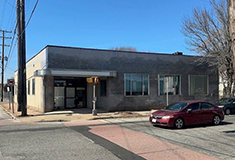News:
Rhode Island
Posted: May 7, 2008
First Bristol Corp. celebrates topping off of $17 million Hampton Inn & Suites
Representatives from the First Bristol Corp. joined mayor David Cicilline and others at a "topping off ceremony" for the $17 million historic rehabilitation and new construction of the Hampton Inn & Suites at 58 Weybosset St.
This building, original home of Old Colony Bank and most recently the St. Francis Chapel, is located in the financial district, adjacent to Bank America, Textron, and Citizens Bank and Johnson & Wales, Brown University and Rhode Island School of Design.
When completed in December, the Hampton Inn & Suites will offer 110 rooms, including 38 suites, 32 king rooms, and 40 standard rooms, and meeting and function space.
This development is a joint-venture with Granoff Associates.
First Bristol CEO James Karam said, "With a strong need for more high-quality lodging with mid-level pricing, combined with the recognition and reputation of Hilton and the Hampton Inn & Suites brand, we expect to be a major competitor in the mid-tier market."
"I commend mayor David Cicilline, the city of Providence and representative Gordon Fox for supporting this project and understanding the value it brings to the city," said Karam.
The Hampton Inn was designed by Newport Collaborative Architects, Inc. (NCA). Design challenges included matching the existing framework to an 11-story new building.
"We're thrilled to be able to save another historic resource and add to the economic revitalization of Downcity," said Michael Abbott, AIA, of NCA.
The hotel's two story, atrium lobby was created by Parker-Torres Designs.
The rehab and new construction by StoneStreet Construction allows for the infusion of new energy efficient materials, minimizing the environmental footprint of the hotel. Green measures include exterior energy efficient windows, high efficient EER-rated HVAC systems, re-circulated heating capabilities, and state-of-the art insulation techniques offering a minimum of R-16 to R-19 insulation value.
Financing for the development was provided by Rockland Trust. The project also secured $4.25 million in state and federal historic tax credits, available for the historic rehabilitation of architecturally significant buildings.
Tags:
Rhode Island
MORE FROM Rhode Island
Washington Trust named one of healthiest employers in Rhode Island by PBN
Westerly, RI For the fourth year in a row, Washington Trust has been named by Providence Business News (PBN) as one of the healthiest employers in Rhode Island. Washington Trust was one of 27 organizations selected for PBN’s 2025 Healthiest Employers Awards,

Quick Hits
Columns and Thought Leadership

The City of Warwick is the perfect choice - by Frank Picozzi
The late summer sky was bright and the mood festive at the family-friendly “Best in Town” event at Rhode Island’s first Floor & Décor store. Those looking to make some home improvements strolled through the warehouse, admiring the well-stocked aisles, fair

Nine Post Rd. receives approval for six units and commercial space - by Frank Picozzi
After several years of planning, the owners of a property in historic Pawtuxet Village recently received planning board master plan approval for a mixed-use building consisting of six residential units and 1,510 s/f of commercial space along the banks of the majestic Pawtuxet River.

Diverse mix of businesses makes Warwick the perfect community - by Frank Picozzi
For those looking for some recreation in the great outdoors, wooded trails and biking paths with spectacular water views, lush green grass perfect for a picnic, fun playgrounds with all the amenities, and modern sports fields can be found easily throughout Warwick. But what does one do when the

Warwick offers convenience of city living, but feels like a smaller, close-knit community - by Frank Picozzi
Located in the heart of southern New England, Warwick is a perfect community in which to locate your business, or find a spot to develop commercial and residential projects. Warwick brings the convergence of air, rail, highway, and maritime travel in one convenient, central location. We’re home to Rhode Island T.F. Green







.png)


.png)